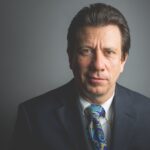What Do Students Need? Findings from the AANMC’s 2020 Survey
FRASER SMITH, MATD, ND
Naturopathic medical school – an accredited first-professional program that prepares a student for entry into a profession – has a pretty clear mandate. Accreditation agencies at the regional/provincial or programmatic level (the Council on Naturopathic Medical Education) set the tone for what a program should strive for. Entry-to-practice examinations, such as the Naturopathic Physicians Licensing Examinations (NPLEX), set a bar that graduates must rise to in order for local regulatory authorities to grant them a license or registration.
Considering the question, “What do students want to learn?” might seem like a secondary concern only because what students need to learn is so extensive. Without doubt, that category of what they “need to learn” defines much of what goes into the curriculum. We don’t ask students if they’d like to learn about femurs but not vertebrae, or about aerobic bacteria but not anaerobes. Nevertheless, because naturopathic practice is such an extensive field, the great variety of modalities used in clinical practice does open up some possibilities.
Graduate Success & Compensation Study
This month, I want to revisit one of the most interesting, well-conducted, and free-to-the-reader publications to come along; it also says a lot about us. I’m referring to the 2020 Graduate Success and Compensation Study,1 conducted and commissioned by the Association of Accredited Naturopathic Medical Colleges (AANMC) and carried out by a professional market research company. Over 1100 alumni across North America, representing graduates from all naturopathic colleges, responded.
The survey sought to discover facts about practice settings, practice foci, income, career satisfaction, multiple credentialing, and more. The associations between some of these data points are also interesting. At the 2021 AANP convention in Phoenix, Dr JoAnn Yanez, Executive Director of the AANMC, gave an excellent presentation about this research. If you have access to this summer’s AANP presentations, I encourage you to watch it. The survey report is cited in the References section of this article,1 but can also be found at www.aanmc.org, under Resources, and then Reports and Research.
Practice Settings
In this article, I will focus on what this research might tell us about student interests. There are many ways to use this type of information. One of the striking things about the data is that in both the United States and Canada, there was a plurality of practice settings. These included not-for-profit organizations, hospitals, universities, and the natural products industry. In Canada, the group practice setting has edged out the solo practice setting as the most common. In the United States, these 2 are close, but solo practice still had slightly more responses than group practice (59% vs 56%, respectively). It might strike the reader as odd that the percentages for these practice settings add up to more than 100%. Is that a new spinoff of Common Core math we somehow missed out on? Actually, it reflects the fact that graduates often practice in more than 1 type of setting. For example, they might do 3 days a week in their own solo practice, and then attend an integrative clinic on 2 other days.
Integrative settings would seem to be an area offering more opportunities. Such settings might be multi-disciplinary outpatient clinics or hospitals. There are core naturopathic medicine skills that might not get full expression in an integrative setting, at least not as frequently if a team composed of other types of practitioners are also managing a case. So, an integrative setting seems like a great component of essential training for entry to practice, but not necessarily an ideal sole activity.
Business Ownership
In terms of ownership, 54% of respondents own their own business, whereas 62% have some form of ownership (like a joint venture). We must continue to include business skills in naturopathic education; with a majority of the graduates in the survey owning a business, it makes sense to introduce students to the essentials of planning, setting up, launching, and managing a practice as small business. There is always more to learn there, and graduates need the help of financial services professionals, such as accountants, and various forms of coaching. The American Association of Naturopathic Physicians (AANP) has announced an updated career center to support member success through all stages of this process. Professional associations in Canada have the same type of services for their members. So while the foundation might be set in medical school, post-graduate resources are easy to find these days.
Clinical Areas of Focus
Another interesting feature of the 2020 survey was areas of focus. These are not so much board certifications, but rather areas of practice focus that were self-reported. These included:
- Digestive/GI Disorders
- Insomnia / Fatigue / Fibromyalgia
- Nutrition
- Mental health/ Mind-body medicine
- Women’s health
- Immune support
- Acupuncture / Traditional Chinese Medicine
- Pain management
- Cardiovascular
- Allergies
- Hormone replacement therapy
- Fertility / Reproduction
- Pediatrics
- Other
The first 6 areas on the above list (“Digestive/GI Disorders” through “Immune support”) were notated in the AANMC’s survey as being strongly associated and often practiced together. The themes of gut and digestive issues, fatigue, immune status, hormonal balance, and women’s health certainly sound familiar to most of us in general practice or a naturopathic college outpatient facility. One thing these conditions or situations have in common is their frequent correlation with a declining level of overall health, decreased resilience, significant levels of inflammation, and increasingly intense symptoms, etc.
Accordingly, the clinical management of all of these areas, including diagnosis, deserves attention in training. However, if you think about it, the naturopathic physician has an incredible advantage in addressing these situations. As Dr Lousie Edwards stated in her interview with the late Dr Jim Sensenig, which was published in the September 2021 issue of NDNR,2 the evidence that naturopathic doctors look for (and I paraphrase here) is not the eradication of the symptoms of disease, but rather the underlying disturbances that generate the symptoms. Conditions such as allergy, fatigue, fibromyalgia, dysmenorrhea, etc, often get worse. Patients tend to take on more and more medications, and usually a few supplements that are fine but not really specific to their case.
”Other”
The category of “Other” in the list of areas of focus contains a very wide array of additional therapies and populations to treat.
The survey showed that 30% of graduates use intravenous therapies in practice, and 35% percent use injection therapies (thus, there are some doctors who might give vitamin B12 injections, for example, but not IV therapies). The naturopathic programs continue to increase their training in this area; however, given its nature, it will remain something that has a post-graduate element to it.
The medicines themselves come into play with both injectables and intravenous routes, so parenteral therapy, in its broader sense, is important. The FDA has attempted to restrict access to these medicines, and some of our doctors have gone to bat to educate and push back against this.3 Dr Michael Cronin and Dr Paul Anderson are 2 doctors who have worked hard on these campaigns.4 In other words, the scope of practice here is not just the delivery method, but also the medicine itself, and we want students to be aware to this aspect of naturopathic materia medica.
Competency
In terms of what students need to be successful, the competency suggested by the “areas of focus” findings is based on abiding by our principle of Tolle Causam. That goes beyond running the tests to establish a medical diagnosis – a necessary but insufficient step in a naturopathic workup. The pathobiography, as termed by Snider et al,5 and an ardent search and analysis of underlying physiological disturbances (including the many rooted in disturbed determinants of health), are important foundations.
Does the naturopathic curriculum at CNME-accredited programs reflect these areas of focus? It would seem so, with coursework in all of these topics. The exploration of root causes of disease is something that each program teaches in its own way, which is what one would expect in a true higher-educational model. There is room for diversity of thinking about how to apply the naturopathic principles; indeed, there are a few content differences across the AANMC member schools. Some that include acupuncture in the local scope of practice delve much more deeply into acupuncture training, but those that don’t include acupuncture happen to have a Masters of Acupuncture available to students.
One way to help students explore some area of focus during the more advanced phases of their training would be field experiences that include observation, as well as placements that allow for patient treatment. These opportunities exist, although an observation opportunity (not fully treatment-oriented, but certainly more engaging than pre-career “shadowing”) in the offices of naturopathic physicians happens every day. Allowing naturopathic medicine interns to acquire more of their core-required internship hours at field sites would be an excellent way to support these interests of students without the schools having to load more content into the curriculum.
Work Week & Cash vs Insurance
One final item to note here, out of many interesting findings in the survey, is that of the work week. Respondents reported an average work time of 41 hours per week of in Canada, and 44 hours per week in the United States, and an overall average of 21 hours per week in face-to-face contact time with patients. The behind-the-scenes practice management aspects of our training will continue to be important.
The move to group practices is both a reflection of interest in integrative approaches and, most likely, a desire to share the administrative, marketing, and billing burden. A cash-only practice is still the more common set up in the United States; however, cash plus insurance is gaining (40% of overall respondents). The Canadian naturopathic doctors represented a larger percentage of cash plus insurance (68%), but this is in a specific context. That is, the patients in this case have provincial health insurance for many medical needs. But many employers, or simply privately purchased plans, afford access to a greater range of services. This is sometimes an annual allotted amount of $500 or $1000 to spend on “other” services, such as naturopathic medicine, chiropractic medicine, acupuncture, etc. This is less about coding and more about the presentation of a bill that lists specific services tied to specific dates, according to whatever the standard of care is in that province.
I encourage you to give that survey a read. It is certainly useful to those of us involved in educating naturopathic physicians. It is one more reliable window of insight into the world of practice we are preparing our students to enter.
References:
- Association of Accredited Naturopathic Medical Colleges. 2020 Graduate Success and Compensation Survey. AANMC Web site. https://mk0aanmc2iy600cqre.kinstacdn.com/wp-content/uploads/2020/06/2020-Graduate-Success-and-Compensation-Study.pdf. Accessed September 25, 2021.
- Sensenig J, Edwards L. The Vital Conversation: Wired for Self-Healing: Part II. Naturopathic Doctor News & Review. 2021;17(9):21-22.
- Anderson P. Exclusive Interview with Dr. Paul Anderson: The FDA and the Fate of Compounded Medicines. February 15, 2019. Journal of Restorative Medicine. Available at: https://cdn.ymaws.com/naturopathic.site-ym.com/resource/resmgr/documents/advocacy/fda/Article_Journal_of_Restorati.pdf. Accessed September 25, 2021.
- Weeks J. Integrative Campaign Challenges FDA on Compounding Pharmacy. August 4, 2016. Integrative Practitioner. Available at: https://www.integrativepractitioner.com/practice-management/news/integrative-campaign-challenges-fda-on-compounding-pharmacy. Accessed September 25, 2021.
- Myers SP, Snider P, Zeff J, DeGrandpre Z. The Assessment Order: Components of a Vitalistic Assessment of Illness, Healing, and Health. In: A Hierarchy of Healing: The Therapeutic Order: A Unifying Theory of Naturopathic Medicine. Textbook of Natural Medicine. St Louis, MO: Elsevier; 2020: 18.

Fraser Smith, MATD, ND is Assistant Dean of Naturopathic Medicine and Professor at the National University of Health Sciences (NUHS) in Lombard, IL. Prior to working at NUHS, he served as Dean of Naturopathic Medicine at the Canadian College of Naturopathic Medicine (CCNM) in Toronto, Ontario. Dr. Smith is a licensed naturopathic physician and graduate of CCNM.









